

Josh Nevett
CarExpert's top five mid-size SUV reviews of 2025
4 Days Ago
The new BYD Atto 3 is one of Australia's cheapest electric cars, and it makes a pretty impressive first impression.
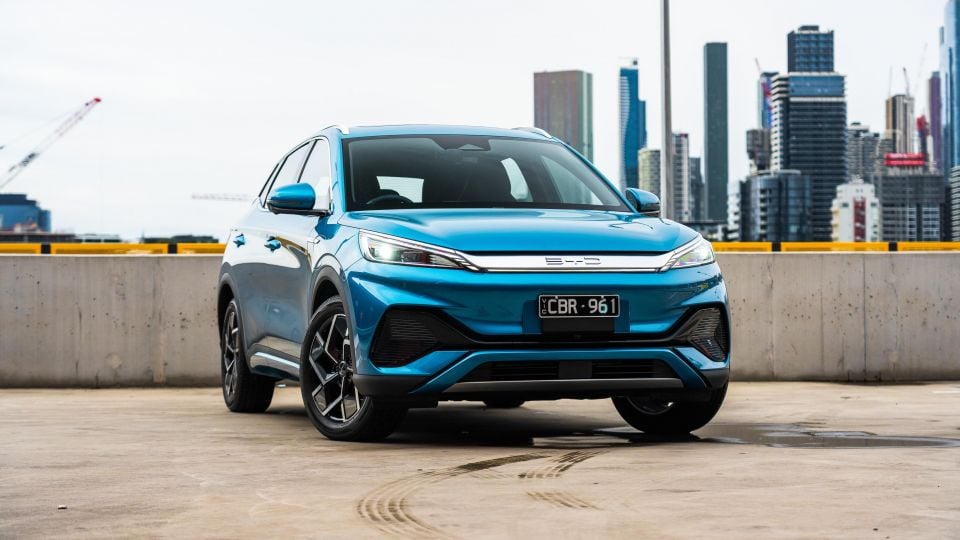
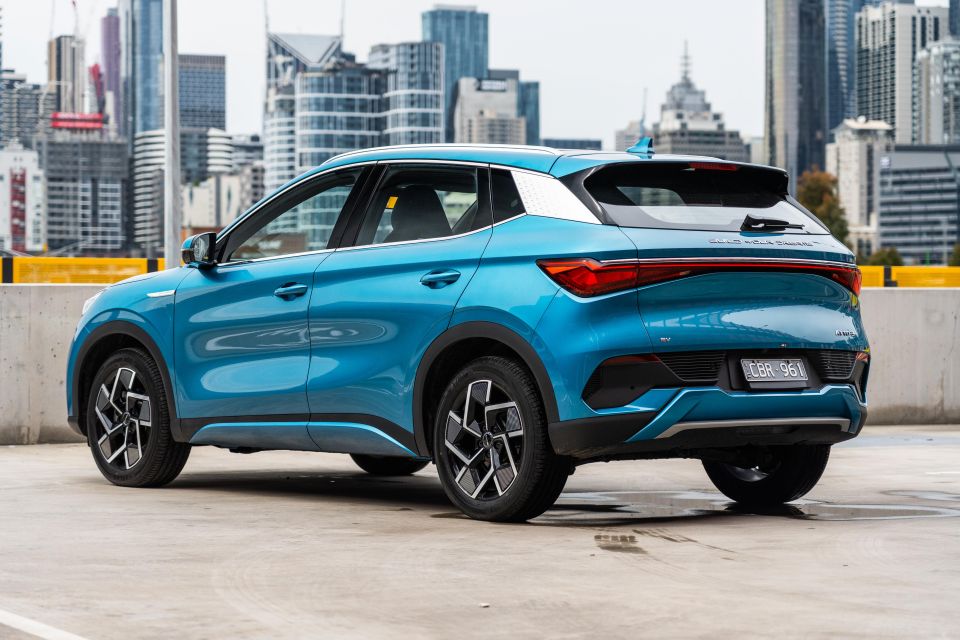

Quickly see how this car stacks up against its competition. Select any benchmark to see more details.
Where expert car reviews meet expert car buying – CarExpert gives you trusted advice, personalised service and real savings on your next new car.
BYD is a giant at home in China, but it’s early days for its expansion into other regions such as Europe, Japan – and of course Australia.
Yet the company viewed as one of the most likely rivals to Tesla has big plans for the local market, with at least three different EV models expected from 2023, using in-house batteries and a bespoke EV platform.
For those wondering if BYD is legit, the company sold 641,000 electrified cars (EVs and hybrids) over the first half of 2022.
Its first serious Australian product is the BYD Atto 3, a small electric SUV that competes against the MG ZS EV, Nissan Leaf and Hyundai Kona Electric, and is available for less than $50,000 drive-away.
Rather than going it alone, BYD teamed up with a middleman called EVDirect to act as importer and distributor.
As well as its own online showroom and physical Experience Centres, the distributor is also working with giant, public dealer group Eagers on the brick-and-mortar footprint.
It’s true that driving a product from a brand you haven’t experienced before is always a novel experience, and signing on the dotted line does come with risk when the distributor is a new player – though as mentioned, BYD itself is far from a minnow on a global basis.
Truth be told, I was pleasantly surprised at how resolved this first ‘global’ BYD product felt. Small wonder the company already claims to hold thousands of orders, which are being shipped as we speak to customers.
Alongside the MG, it promises to be a bit of a game changer in the sub-Tesla EV market, with a good price point and supply lines that are expected to actually support demand levels.

There are two choices of battery: the Atto 3 Standard Range at $44,381 before on-road costs, and the Atto 3 Extended Range driven here at $47,381 before on-road costs. These are both painted white, with grey, blue and red each costing a further $700.
UPDATE: Pricing for the Atto 3 has changed for 2023. An updated price list is available in our price and spec story here.
Our test car’s $47,381 sticker price turned into about $50,900 drive-away using a Melbourne postcode and including the added cost of the blue metallic paint.
But remember that many Australians are also eligible for EV rebates – $3000 in Melbourne and Sydney for example – to offset State taxes and other miscellaneous fees. Bottom line, the only EV on sale that’s cheaper than the BYD Atto 3 is the $44,990 drive-away MG ZS Excite, but this vehicle is smaller and has a lower range.
Such is the early interest, BYD Australia’s distributor says people who place an order today will be waiting until February or March 2023 for delivery.
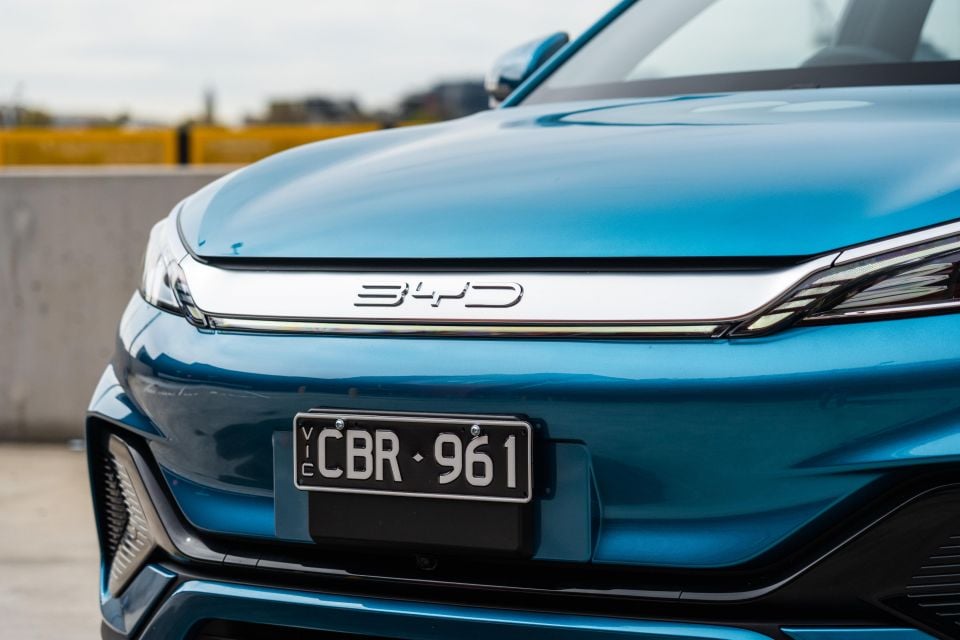
A Nissan Leaf by contrast costs $50,990 to $61,490 before on-road costs depending on battery, and a Hyundai Kona Electric costs from $54,500 to $64,000 before on-road costs depending on both battery and equipment.
Not only will the BYD surely appeal to those committed to making the switch to their first EV, but the price might also sway people out of various petrol or hybrid SUVs of similar dimensions too.
The $48,000 drive-away Mazda CX-30 Astina range-topper comes to mind, as does the $47,000 drive-away Honda HR-V e:HEV L hybrid.
UPDATE: Pricing for the Atto 3 has changed for 2023. An updated price list is available in our price and spec story here.
BYD Atto 3 pricing
Drive-away prices based on a Melbourne postcode, and are calculated before any rebates.
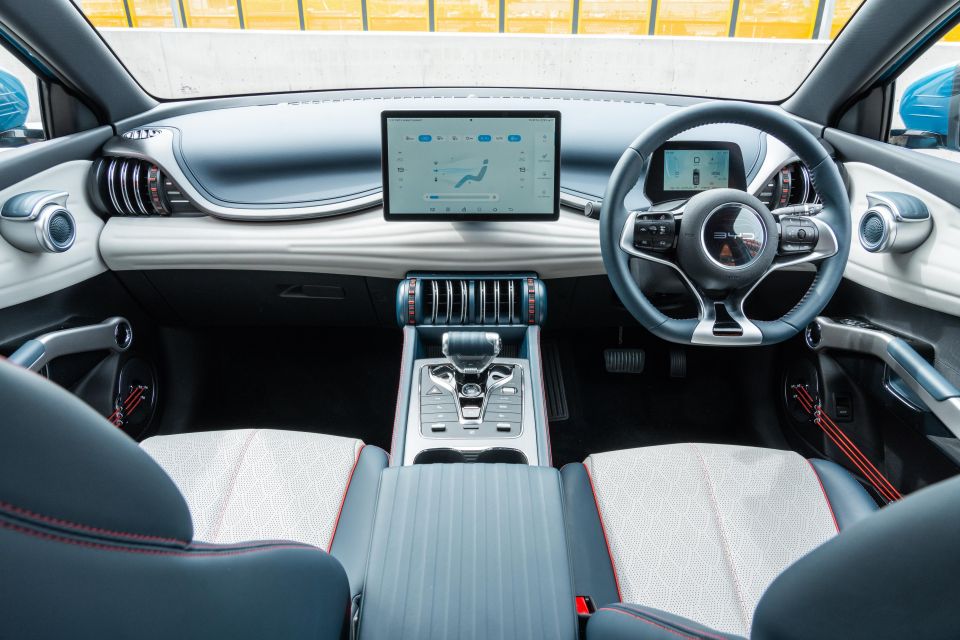
Buy your new car without the stress. It's fast, simple and completely free.

Great service from Travis and team, second time I have used this business would not hesitate to recommend them to anyone
Craig C.
Purchased a Ford Ranger in Sunshine Coast, QLD
CarExpert helped Craig save thousands on his Ford Ranger, now let us save you on your next new car.
Find a dealYou can see some clear Mini influence in here, and some Volkswagen Group-style switchgear along the centre tunnel. Design is subjective, and it certainly stands out, though I’m quite sure it’ll polarise.
The blue, cream and red colour scheme brings a real point of difference which, love or hate, stands apart from the drab grey and black cabins we’re used to seeing. There’s almost none of the in-vogue piano black trimming either, which is certainly a positive.
There are brash LED light signatures that pop at night, and a big panoramic glass sunroof with powered cover – albeit a thin one.
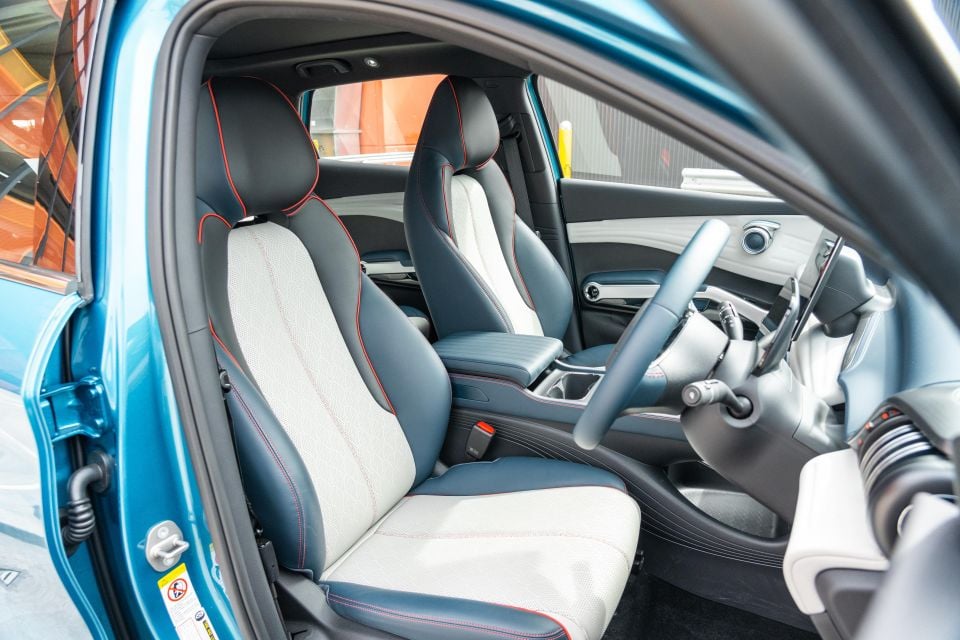
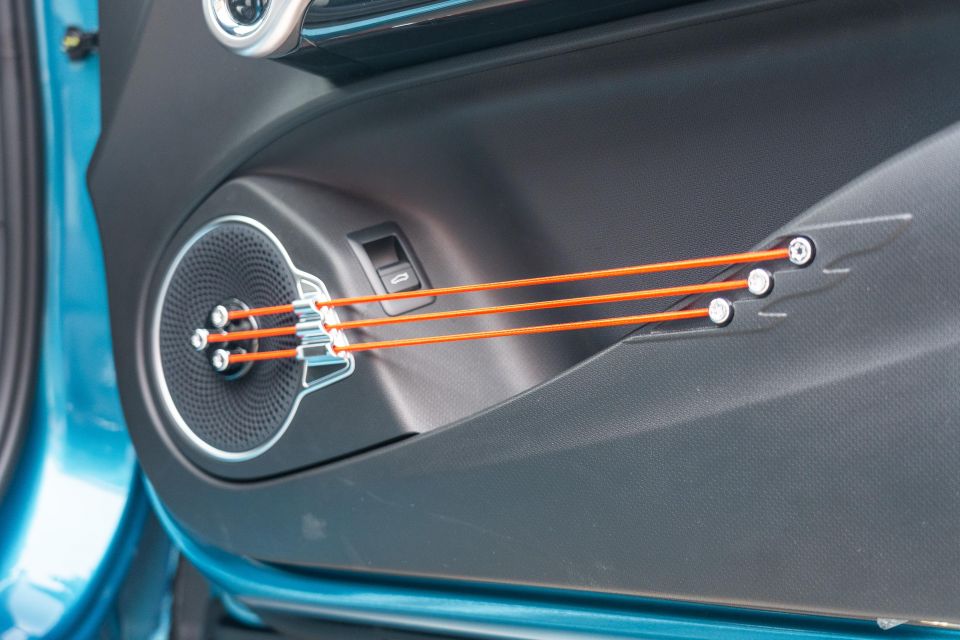
Overall interior build and material quality is actually very good, with few signs of obvious cost-cutting.
Enter with an open mind and you’ll be impressed, with the first observation being the reassuringly heavy ‘thunk’ from the door as it shuts you in.
I was expecting it all to feel a little cheap and nasty, so an early tick is awarded.
There are padded surfaces on the doors and along the dash. The centre tunnel, unusual pull-back circular door handles, and console lid feel very sturdy. Even those cylindrical lower vents click and clack into place decisively.
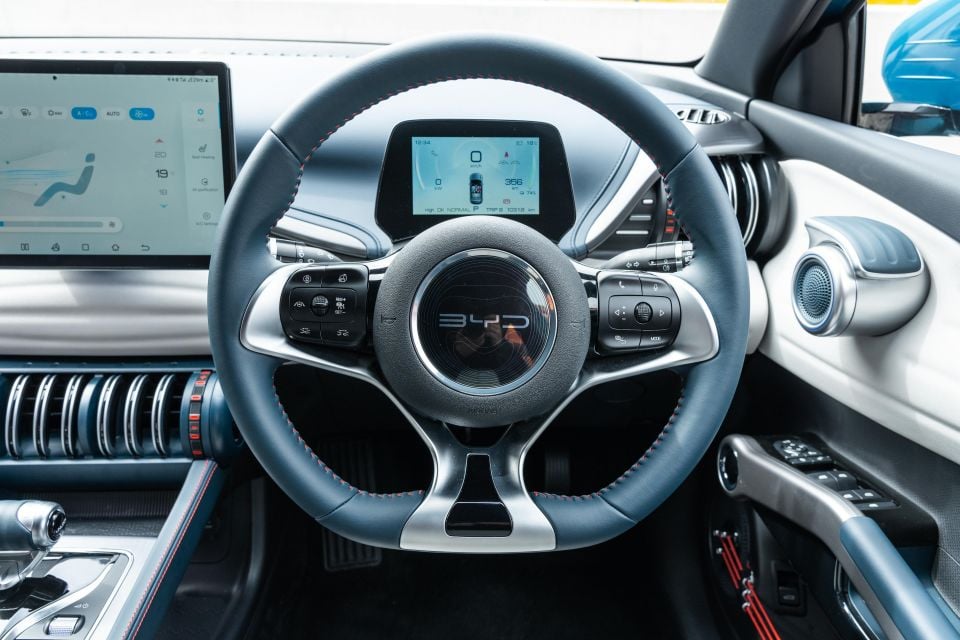
Moreover the power-adjustable and heated (through the touchscreen, ergh) seats are trimmed in good quality, soft, and perforated synthetic leather trim coloured blue and cream with red piping.
That said, the one-piece backrest caused a minor issue for taller drivers such as myself (194cm), as the fixed headrest supported my shoulders more than my neck.
The steering wheel adjusts for rake and reach, and is trimmed in blue leather. There are simple buttons on each spoke for active cruise control functions and audio controls, with a fun little roller ball for volume controls.
It’s worth calling out the fact that BYD went to the trouble of moving the indicator to the right-hand side of the steering column – something many brands focused on left-hand drive markets rarely bother doing.
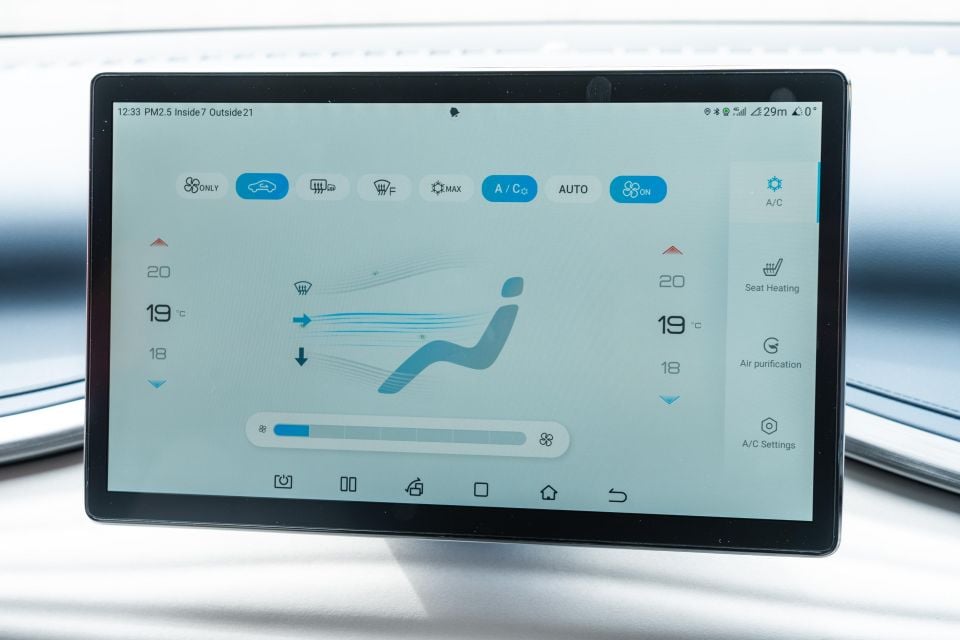

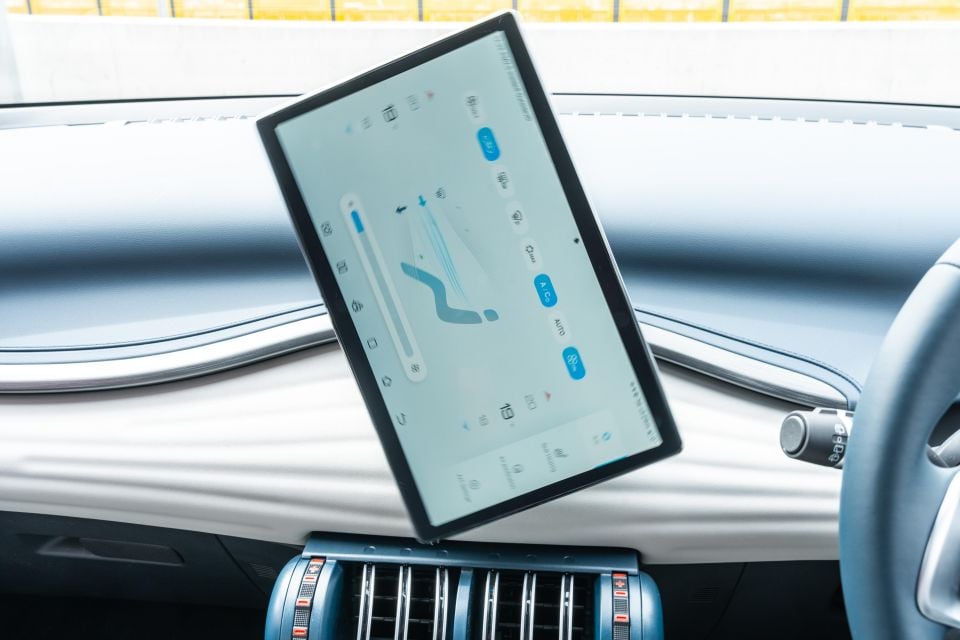

In place of a traditional instrument cluster is a 5.0-inch screen perched atop the column which I found perfectly legible. It shows your speed digitally, remaining range, tyre pressures, current power usage or rate of recuperation, lane-assist function, and active cruise control settings.
Moving down to the centre tunnel, there’s a gear shifter that looks to be inspired by a plane’s thrust lever. Behind this is a stylish starter button, knurled roller dial for audio volume, and a bank of Audi-aping, sturdy buttons assisted by rocker switches.
Functions able to be controlled or adjusted here include the parking sensors, blind-spot monitoring, Auto Hold, air-conditioning on/off, windscreen de-fogger, accelerator and steering weight modes, and the degree of brake-energy recuperation.
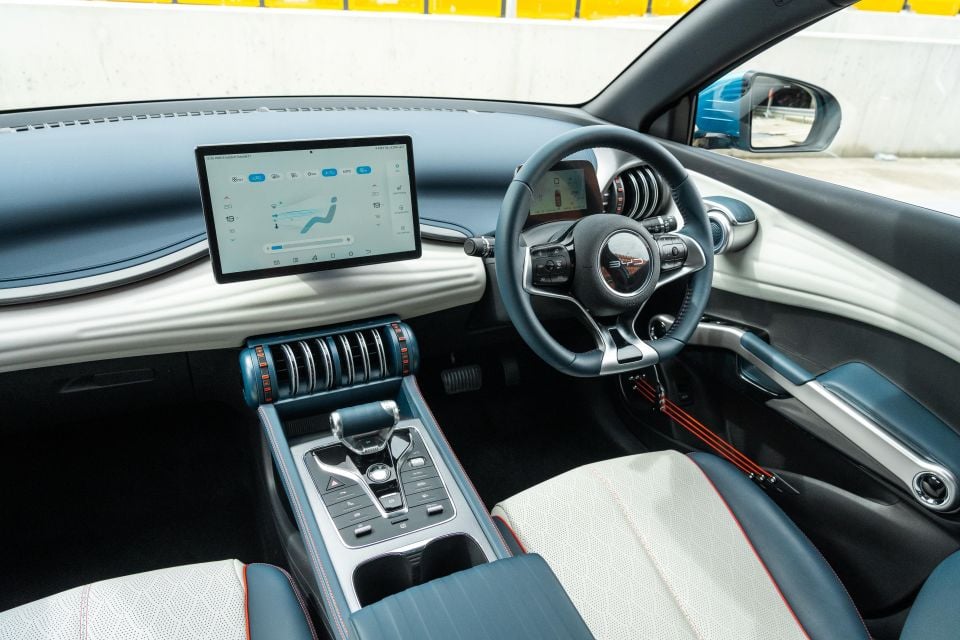
The real standout feature in here is the Android-backed touchscreen, which measures 12.8 inches and offered fantastic clarity and quick processing of inputs with almost no lag. As a party trick, it also spins 90-degrees with a button on the wheel, so you can view maps in portrait.
One small note: In portrait mode the spinning screen becomes invisible when you are wearing polarised sunnies.
Sat-nav was not available when we picked the car up, but lo and behold an over-the-air (OTA) software update added sharp embedded mapping a few days later, alongside Spotify integration (using your own login) and conversational voice controls for functions including the sunroof.
The system updates are just like downloading a new version of iOS. The future is now!
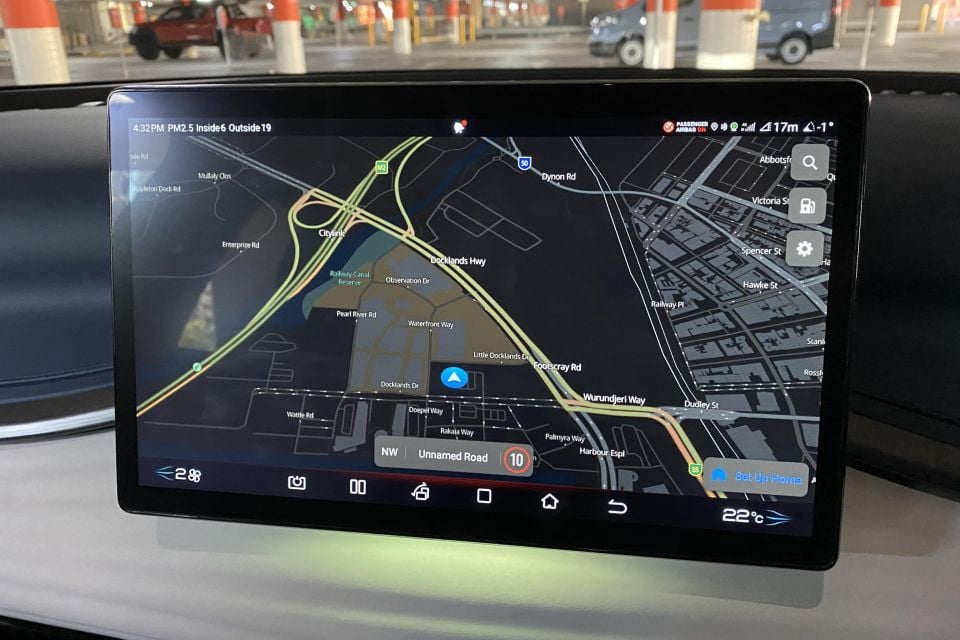
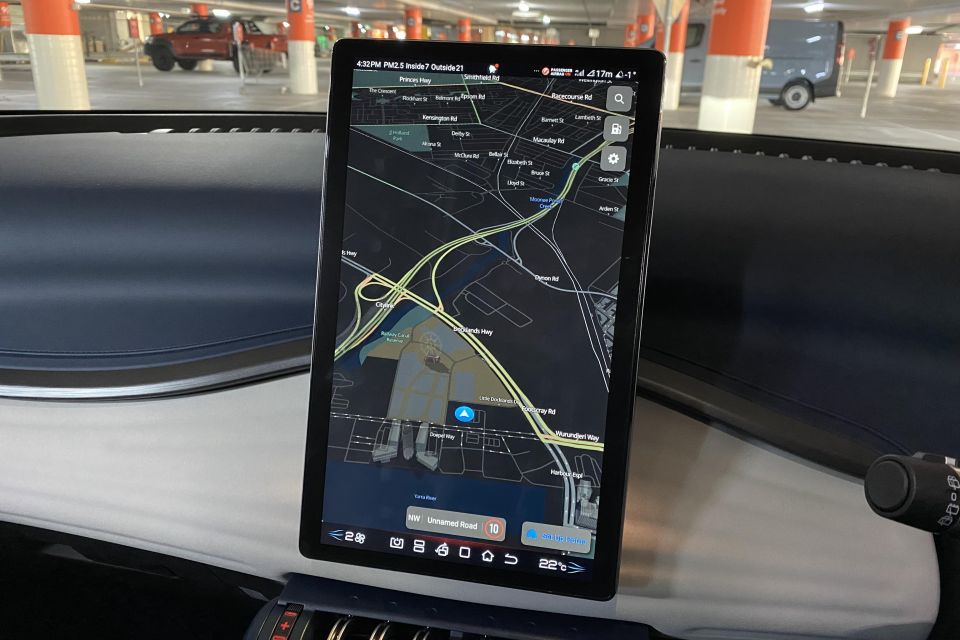
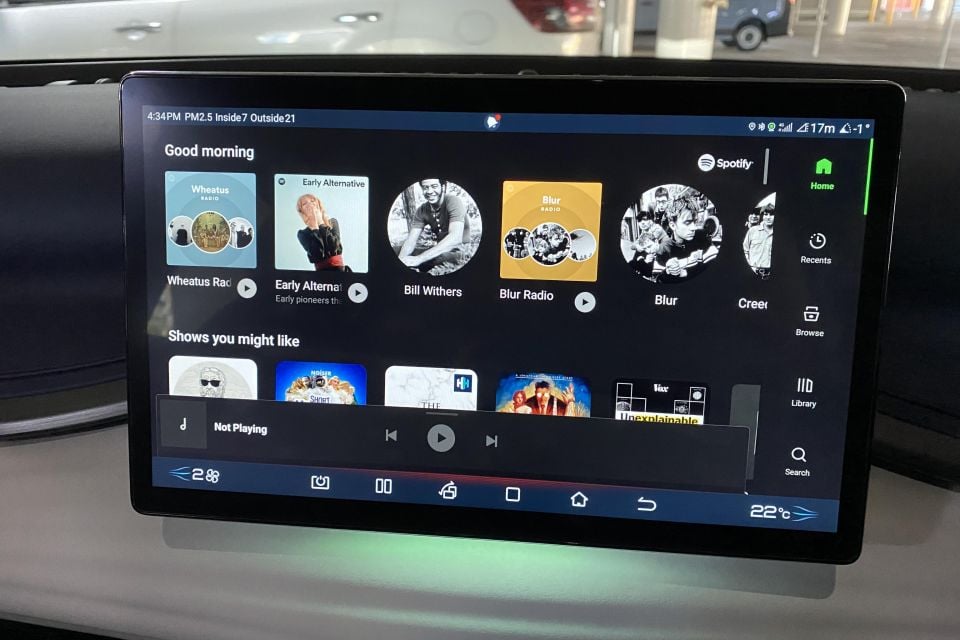
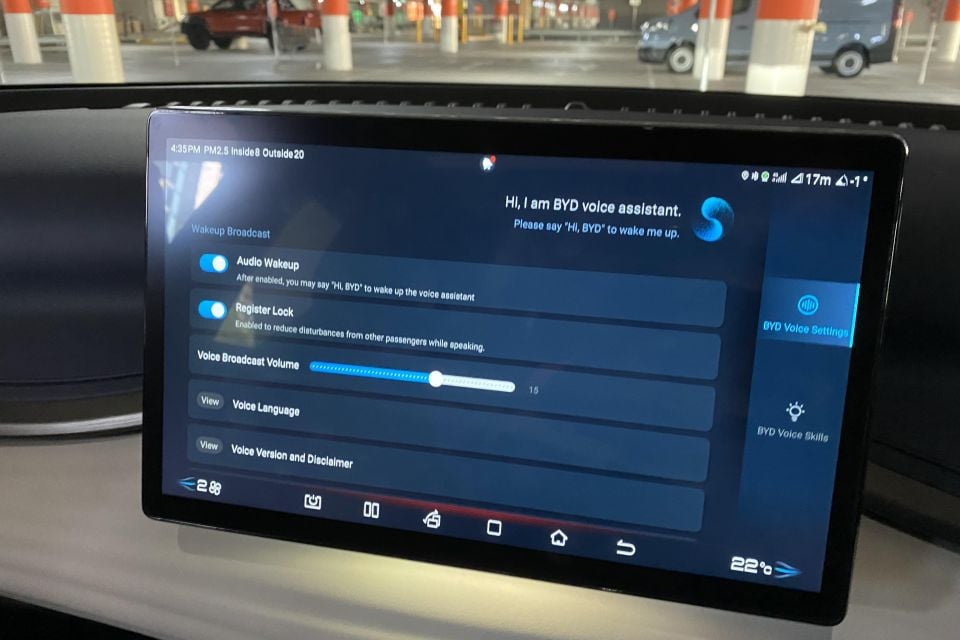
Apple CarPlay and Android Auto – not yet available – are also expected to become available OTA shortly, likely in late October or early November.
You get USB-C and USB-A points, Bluetooth streaming and audio that re-paired rapidly every time, and a digital radio receiver (DAB). Other highlights include the really sharp 360-degree camera with various angle options, and the excellent eight-speaker sound system from Dirac.
Our car also had an inbuilt, forward-view driving recorder or dash cam that saved the last few trips, and placed them in the touchscreen to view and – if needed – lock. This system also doubles as a forward-facing video and stills camera.

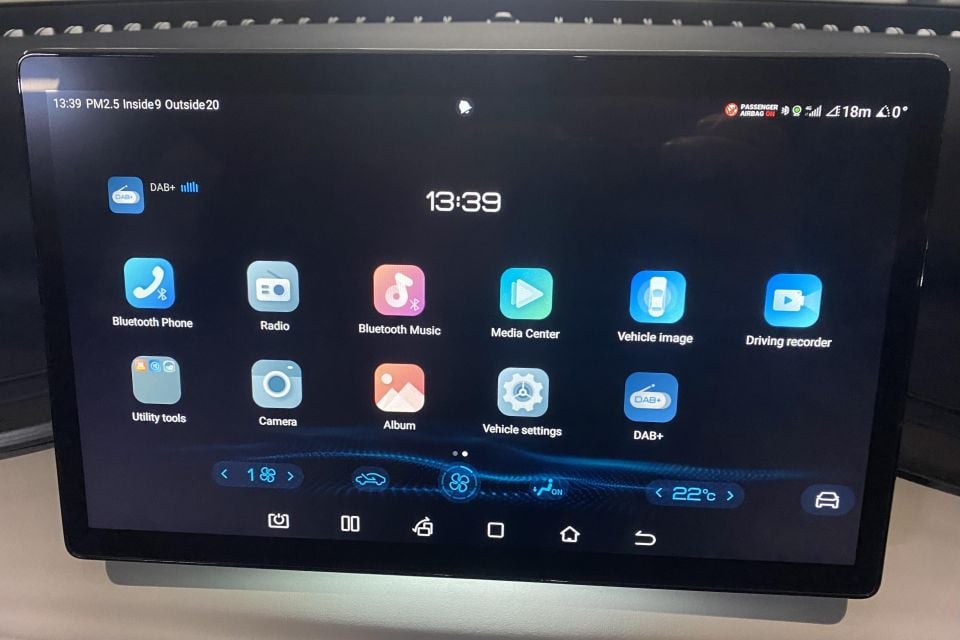
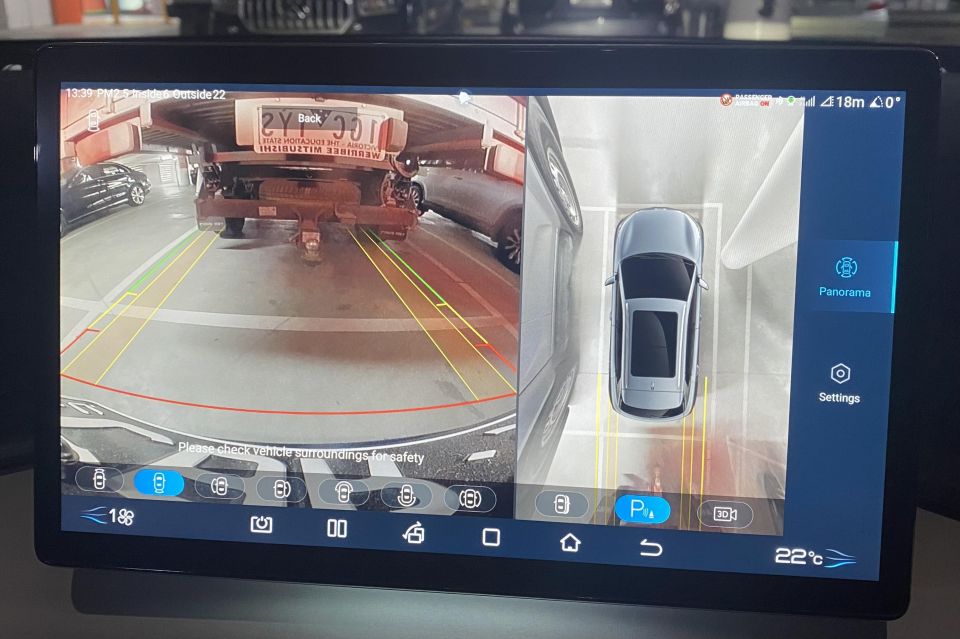
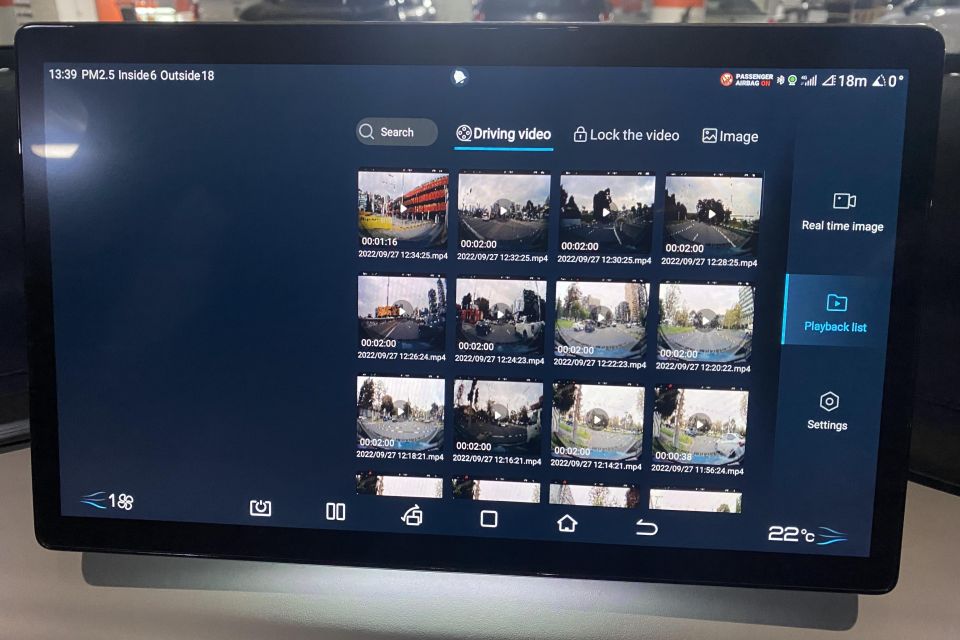
Storage options include the concealed section below the gear shifter which is helpfully backlit at night, a centre console deep enough for a big water bottle, and a decent glovebox. There’s also a rubbery wireless charger pad below the vents.
See those three elastic straps on each lower door section? They’re screw-mounted and taut enough to be played like a guitar string. I’m sure the novelty fades fast…
Those back seats are quite good, with the good material mix maintained, ample legroom for my 194cm frame, and a totally flat floor enabled by the EV-only platform. That said, the sunroof does eat into headroom for taller occupants.
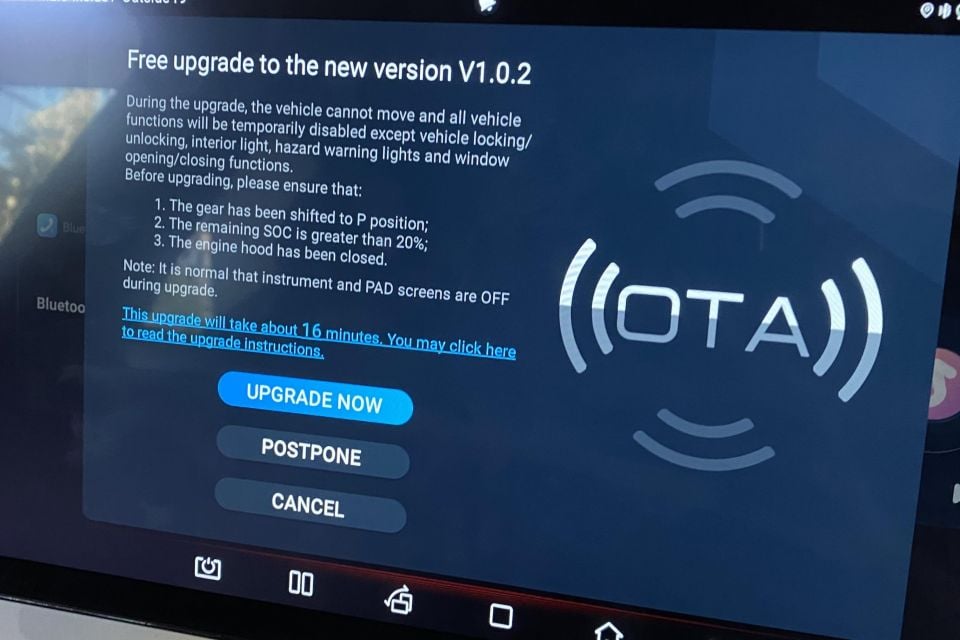
Amenities include a flip-down armrest with cupholders, map pockets, top-tether and ISOFIX child-seat attachment points, rear air vents, and both USB-A and USB-C points. There is also more swish colourful LED lighting back there.
The tailgate is powered at the press of a button, and reveals a 440-litre boot which expands to 1340L when you fold the back seats down. However the boot floor is quite high, and a large check-in suitcase will about max it out.
Below the boot floor you get a tyre repair kit rather than any sort of spare wheel.
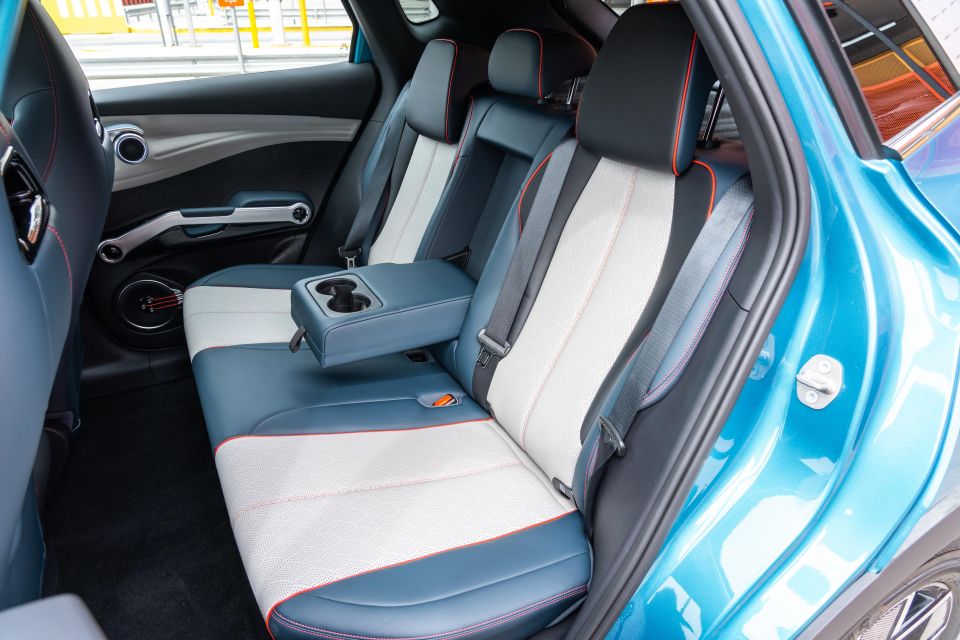
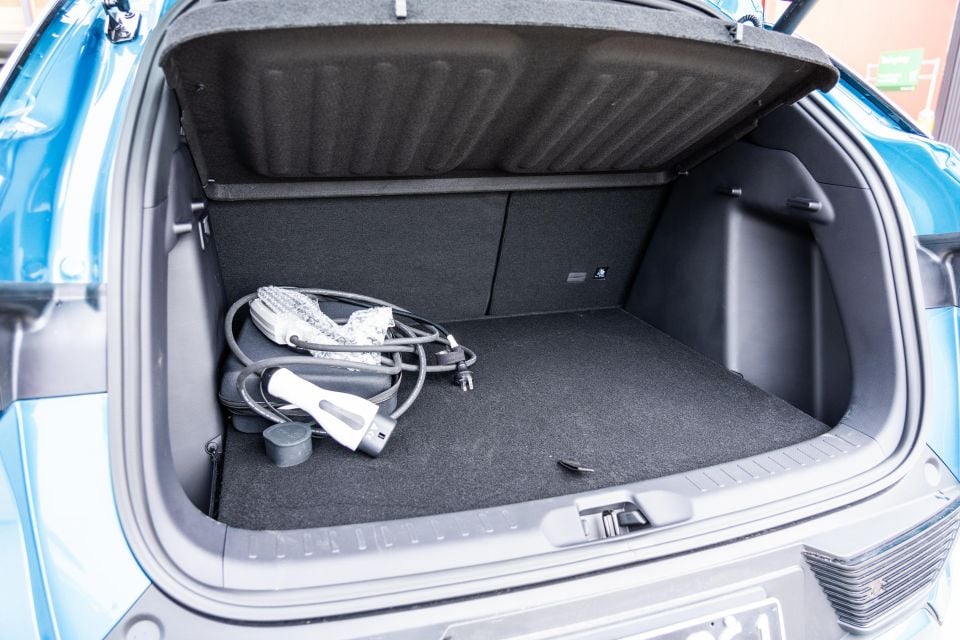
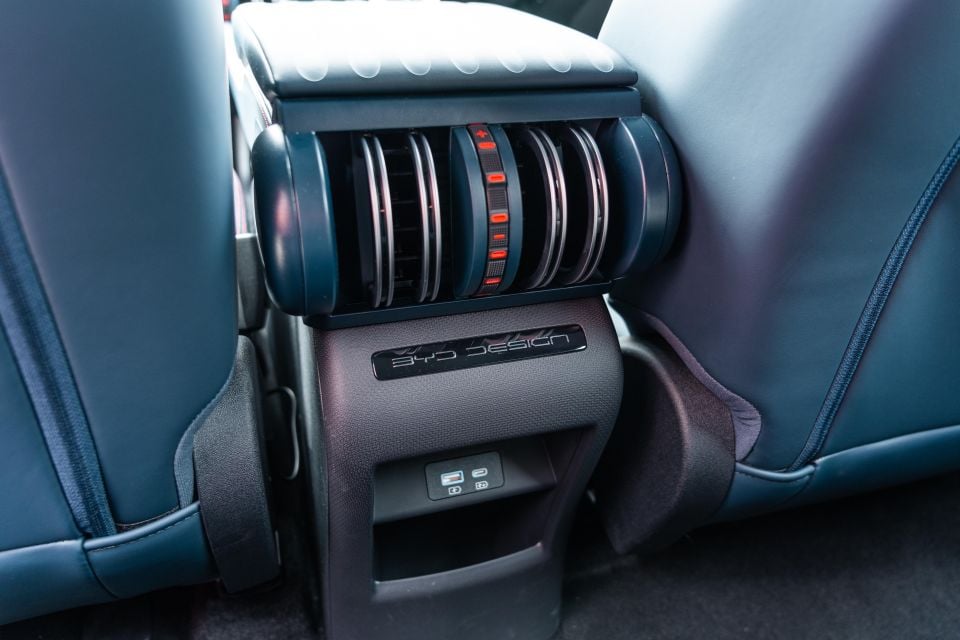
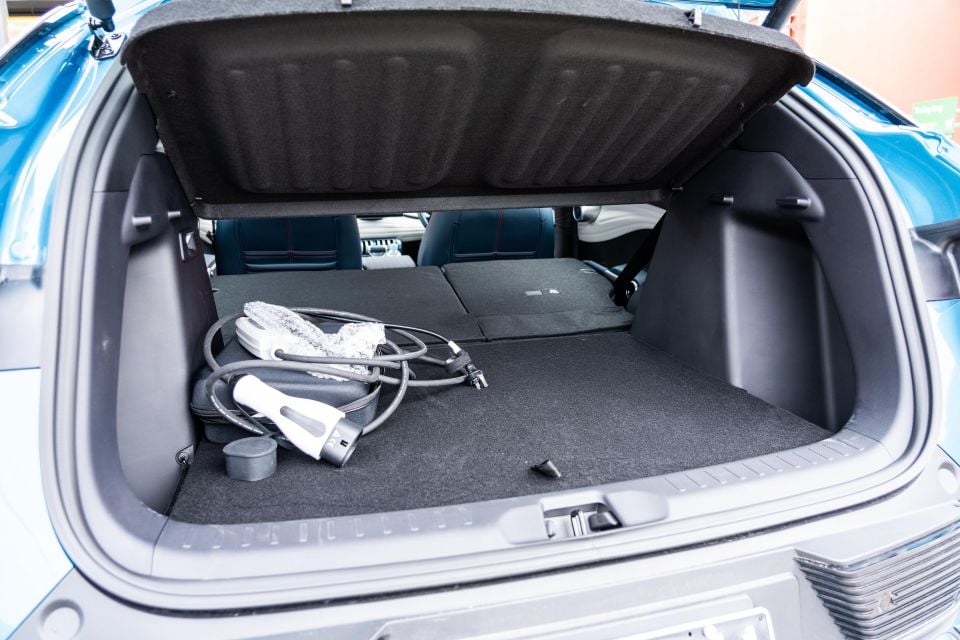
The BYD Atto 3 is front-wheel drive and powered by a 150kW and 310Nm permanent-magnet synchronous motor.
The motor in our Extended Range model is fed by a 60kWh ‘BYD Blade’ in-house battery using lithium iron phosphate chemistry – the same as a Tesla Model 3 – with a distinct cell arrangement. The Blade battery aced the tough nail penetration test without overheating.
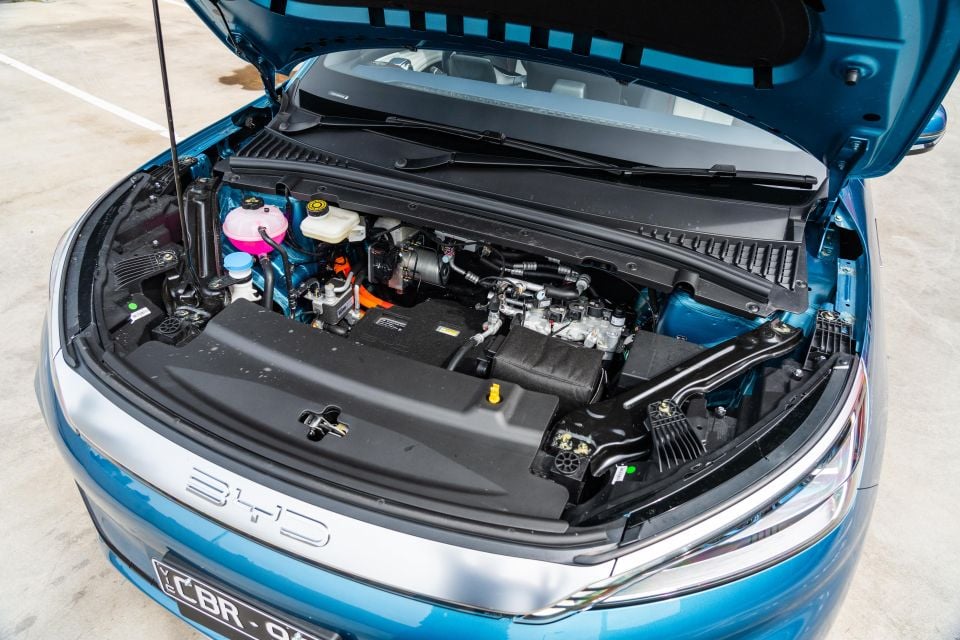
BYD claims the Atto 3 Extended Range offers a WLTP driving range of 420km per charge, whereas the Australian domestic figure using the less realistic NEDC range test is 480km.
In terms of charging, there is a three-pin AC trickle charger that you can plug into your wall powerpoint with a Type 2 plug for the car. But if you have off-street parking you should buy a home wallbox for a few grand which will top the car up much quicker, overnight.
I also visited a local Chargefox public DC CCS charger and added 50.1kWh of electricity (about 80 per cent of the battery capacity) in 45 minutes. The peak charging rate I saw was 90kW, before it tapered off to 60kW above half-full state, and slowed further near the end.
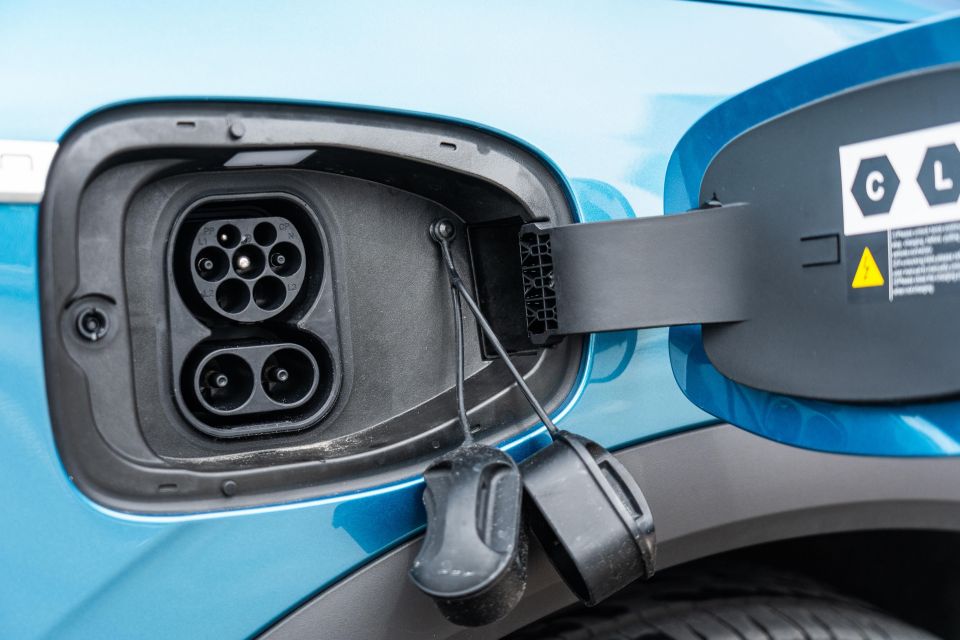
Where expert car reviews meet expert car buying – CarExpert gives you trusted advice, personalised service and real savings on your next new car.
BYD Atto 3 Extended Range tech specs:
Short range option?
Those who want the cheaper BYD Atto 3 Standard Range option can opt for a smaller 50kWh battery and save $3000, in exchange for about 65km less range.

Power delivery is smooth and instantaneous, as are all EVs, although urgent take-offs in which you stab the throttle might elicit a bit of front wheel spin.
The official zero to 100km/h time is 7.3 seconds, which I nearly matched with a 7.5sec run on my first crack.
There are two levels of brake-energy recuperation, but the difference between the two levels is hard to pick up, and there’s no one-pedal driving option.
My consumption average on a defined drive loop was 14.3kWh per 100km from a circa 60kWh pack – suggesting a circa-400km real-world range is quite manageable.
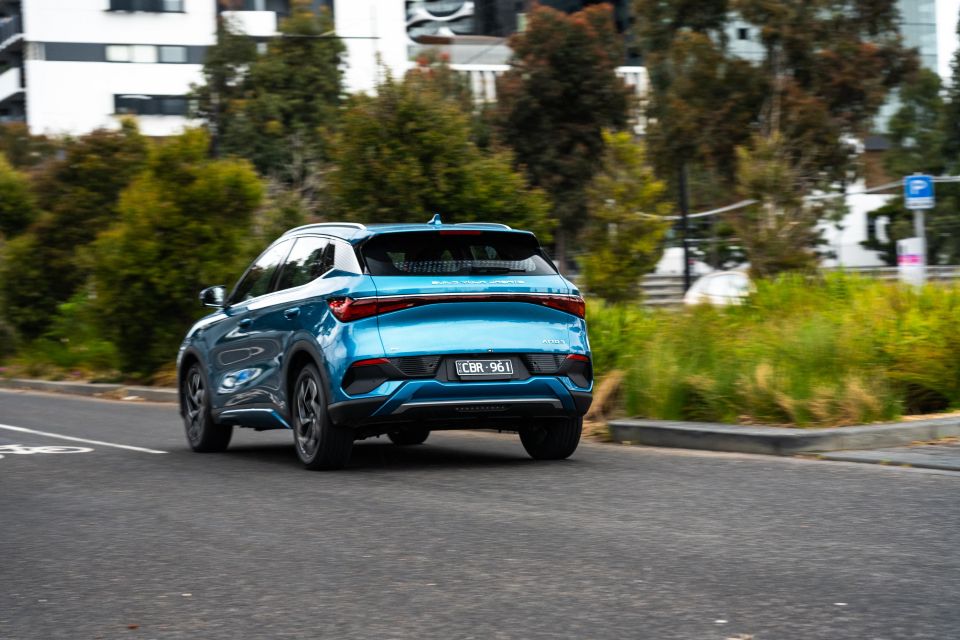
Considering the WLTP claim is 420km, this is perfectly reasonable.
For those keen on longer trips, it needs to be pointed out that EVs tend to less efficient on higher-speed country drives because there is less chance to recuperate waste energy.
I drove 260km in the country at average speeds of 100km/h to 110km/h, and used 70 per cent of the battery storage doing so, meaning you should expect around 330km-340km in this circumstance.
The degree of refinement is quite impressive, with minor wind noise from the side mirrors the only thing that really breaks up the serenity.
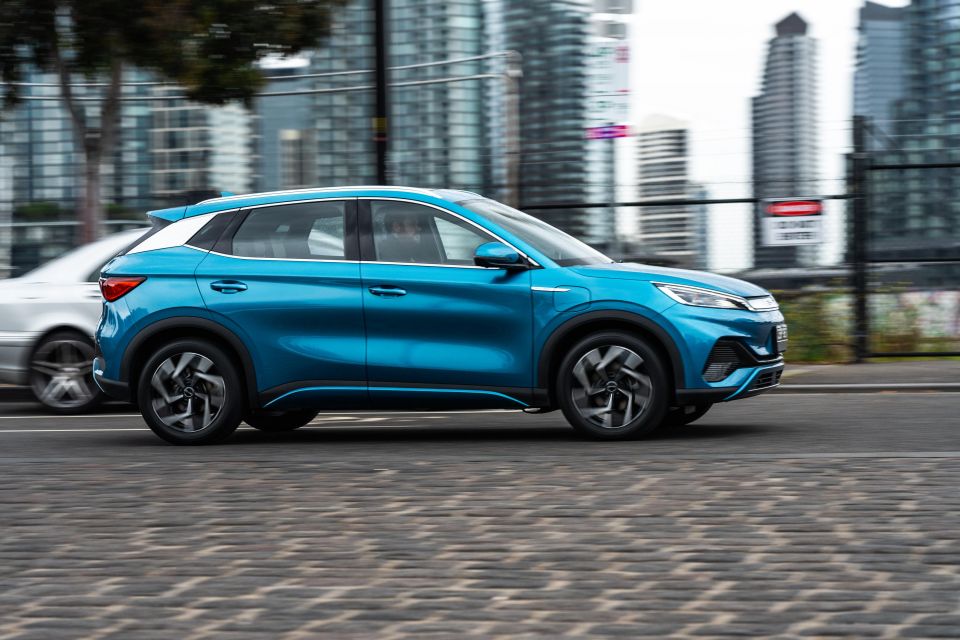
Those who are yet to experience the smooth power delivery and overall refinement of an EV really should. For daily commuting it’s preferable every time.
The Atto 3 uses conventional MacPherson strut front, and multi-link independent rear suspension, and it’s tuned to be very soft and pliant, offering decent levels of isolation from expansion joints and cobblestones.
On the negative front, the Atlas Batman A51 tyres didn’t seem all that confidence-inspiring – wheelspin was an issue off the line – and the handling or body control feels a little unwieldy with noticeable body movement in corners and vague electric power steering.
Respectively smooth and refined yes, but if you want something that feels agile in corners this falls a bit short.
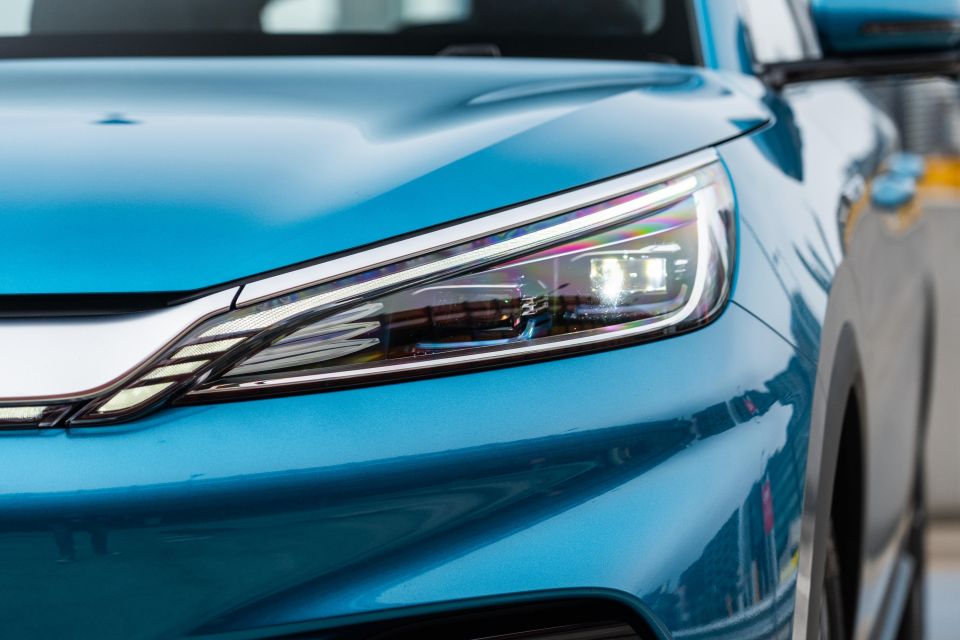
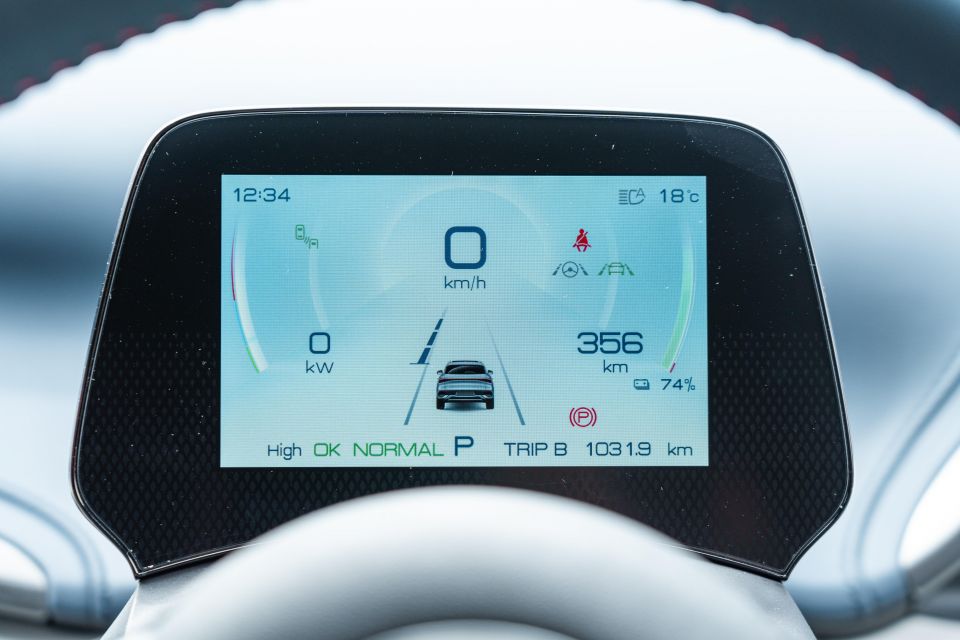
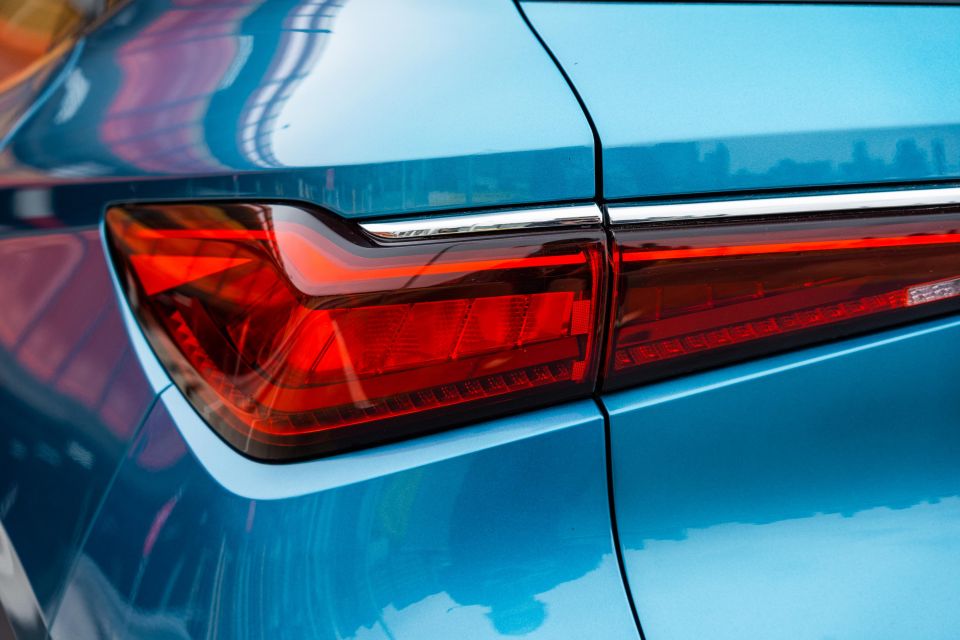

There’s a pretty strong list of standard features.
Exterior
Interior
Coming in fourth quarter via OTA
*According to BYD Australia

BYD says Euro NCAP and its partner organisation ANCAP are working on a crash test score, but there is nothing available on that front right now.
Safety features include
Driver assists include
The BYD Atto 3 can therefore mirror the speed of the car ahead, steer between road lines, and tell you when there’s a car in your blind spots.
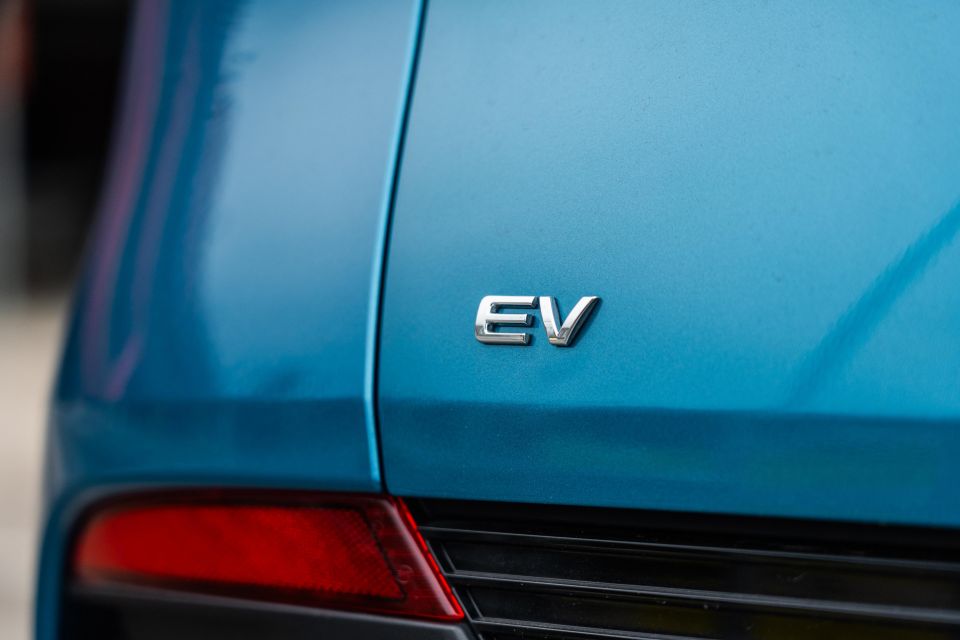
The vehicle warranty nominally covers six years or 150,000, whichever comes first, and the battery is covered for eight years or 160,000km, to offer at least 70 per cent of its original storage. You also get 12 months of 24/7 roadside assistance.
Servicing can be performed either at a BYD Service and Repair Centre, part of the aforementioned Eagers network, or at certain independent mycar sites. Mycar, formerly Kmart Tyre & Auto, has a partnership deal with BYD Australia to help maximise its service coverage.
At the time of writing there were 30 service sites for the Atto 3 open, and 11 more listed as “coming soon”, covering all regions bar the Northern Territory.
Make sure you have a good look at all the terms and conditions for the warranty program, because there are some.
Those who have been following the BYD rollout might recall its Australian distributor this month responded to widespread criticism, cutting the proposed service pricing but standing firm on the warranty.
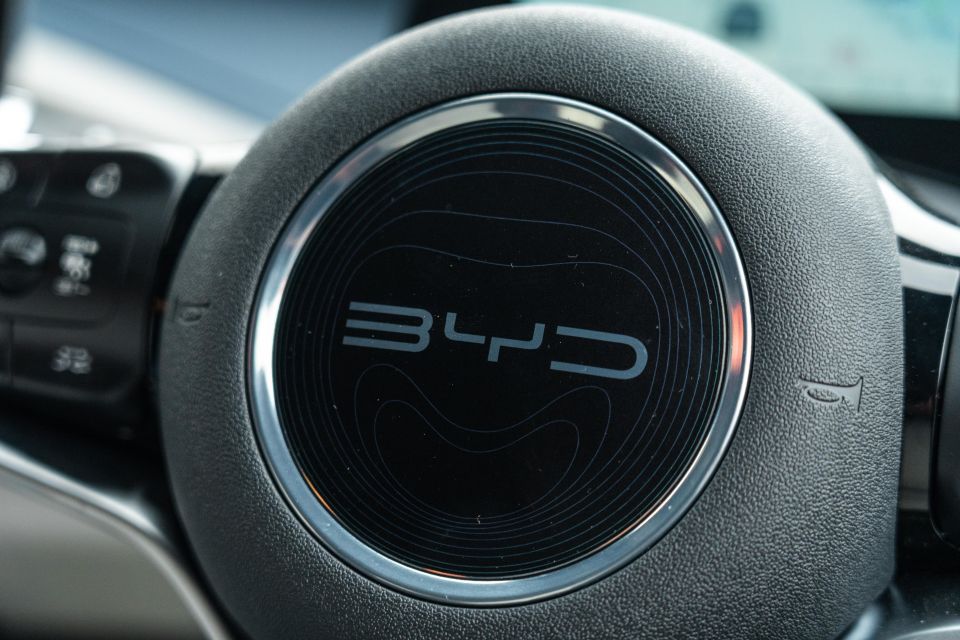
Latest standard BYD servicing plan
That’s an average of $299 per visit over the first eight years.
There is a cheaper option for those who drive lower mileage, however. You can pay fixed prices of $189 for every 12 month service up to the five year or 60,000km service – if you fit this bill, averaging 12,000km annually or less.
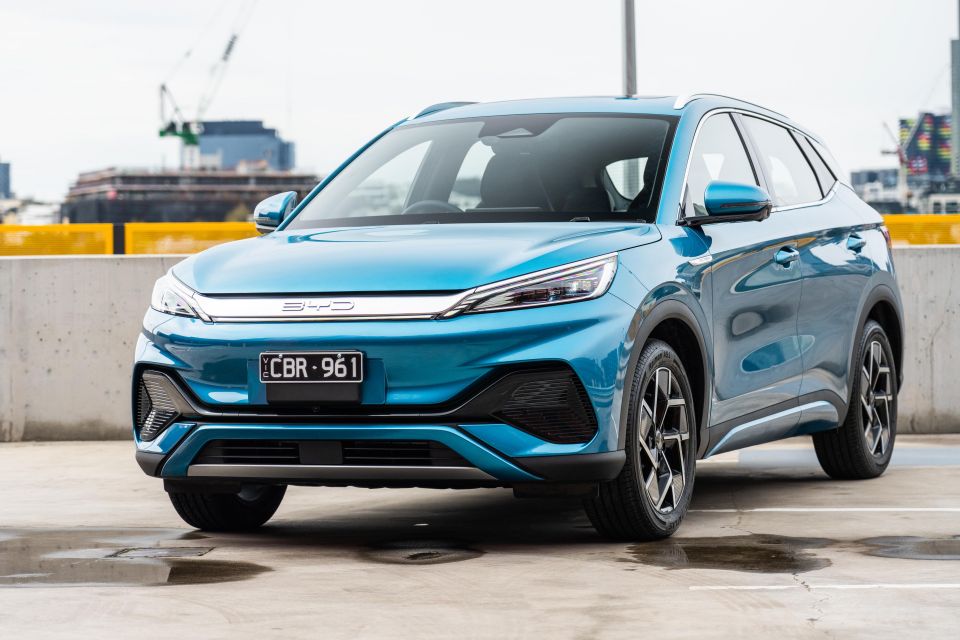
So that’s a look at the BYD Atto 3.
Easily fixed negatives include the lack of Apple CarPlay and Android Auto at the time of writing (an over-the-air update is expected soon), and absence of an ANCAP test score to verify the safety (again, to be rectified soon, result pending).
BYD would also do well to offer a suspension and tyre tweak that sharpens up the handling because this is not an agile machine in corners.
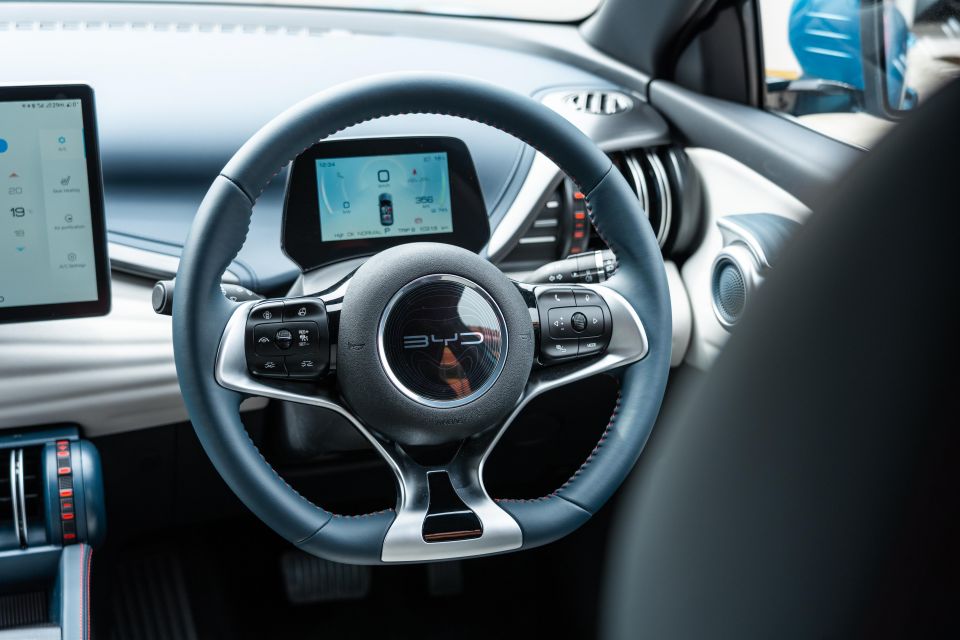
Moreover, while EVDirect and Eagers have big plans, there is always an element of risk being an early mover in terms of aftersales support. Simply put, it’s a new operation here.
But it cannot be denied that the BYD Atto 3 is a well-engineered EV, with decent range for the price, excellent refinement, ample punch, a spacious and well-made interior, and excellent technologies culminating in the sharp and rapid touchscreen.
BYD products have all the attributes to make a serious impact on the Australian car market over the next few years, and last time I checked, competition is rarely a bad thing. Definitely a brand to watch…
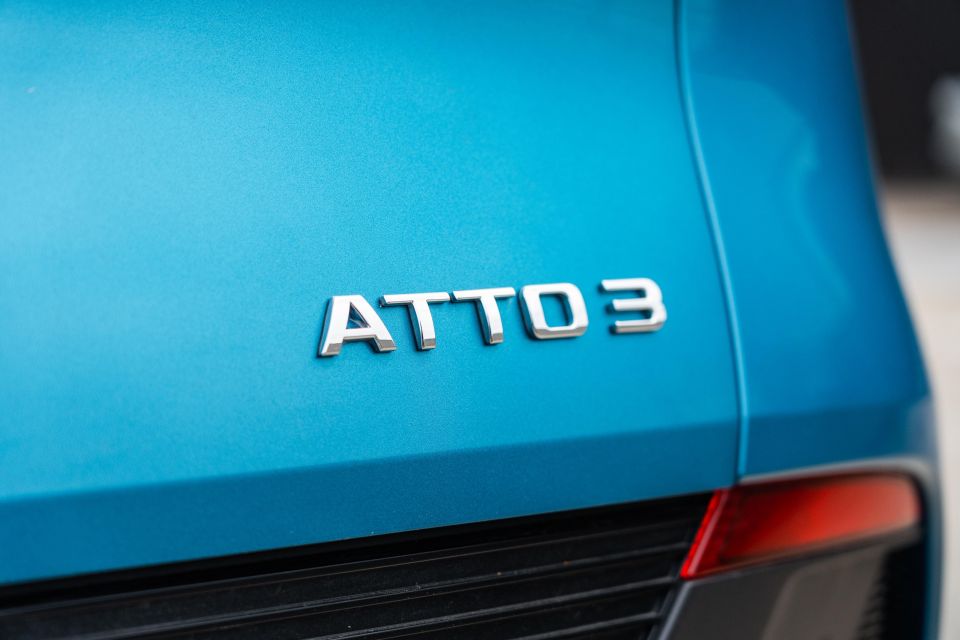
Click the images for the full gallery
MORE: Everything BYD Atto 3
Where expert car reviews meet expert car buying – CarExpert gives you trusted advice, personalised service and real savings on your next new car.


Josh Nevett
4 Days Ago


Ben Zachariah
5 Days Ago


Derek Fung
6 Days Ago
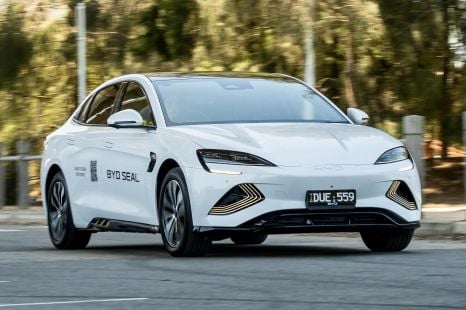

Max Davies
12 Days Ago
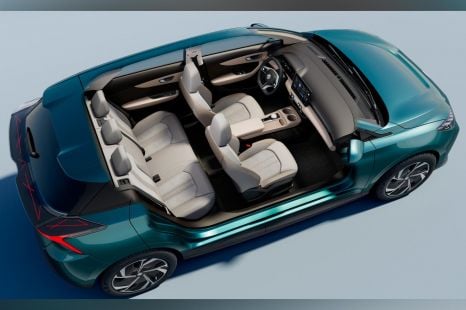

William Stopford
13 Days Ago
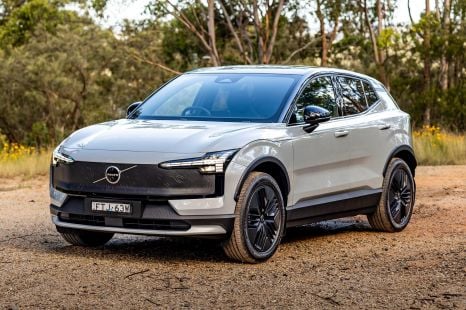

Matt Campbell
14 Days Ago